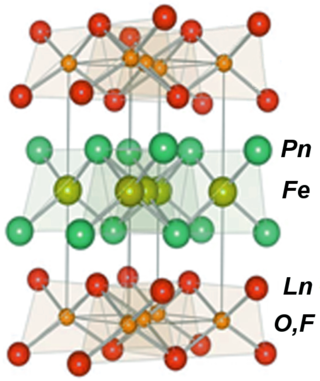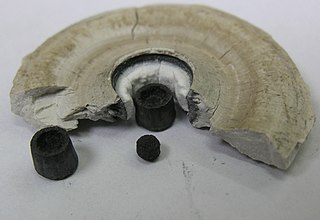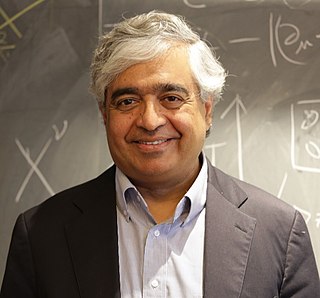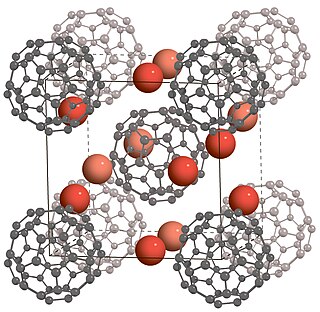Related Research Articles
Unconventional superconductors are materials that display superconductivity which does not conform to conventional BCS theory or its extensions.

High-temperature superconductors are defined as materials with critical temperature above 77 K, the boiling point of liquid nitrogen. They are only "high-temperature" relative to previously known superconductors, which function at even colder temperatures, close to absolute zero. The "high temperatures" are still far below ambient, and therefore require cooling. The first break through of high-temperature superconductor was discovered in 1986 by IBM researchers Georg Bednorz and K. Alex Müller. Although the critical temperature is around 35.1 K, this new type of superconductor was readily modified by Ching-Wu Chu to make the first high-temperature superconductor with critical temperature 93 K. Bednorz and Müller were awarded the Nobel Prize in Physics in 1987 "for their important break-through in the discovery of superconductivity in ceramic materials". Most high-Tc materials are type-II superconductors.

In superconductivity, Homes's law is an empirical relation that states that a superconductor's critical temperature (Tc) is proportional to the strength of the superconducting state for temperatures well below Tc close to zero temperature (also referred to as the fully formed superfluid density, ) multiplied by the electrical resistivity measured just above the critical temperature. In cuprate high-temperature superconductors the relation follows the form

In physics, topological order is a kind of order in the zero-temperature phase of matter. Macroscopically, topological order is defined and described by robust ground state degeneracy and quantized non-Abelian geometric phases of degenerate ground states. Microscopically, topological orders correspond to patterns of long-range quantum entanglement. States with different topological orders cannot change into each other without a phase transition.

In condensed matter physics, a pseudogap describes a state where the Fermi surface of a material possesses a partial energy gap, for example, a band structure state where the Fermi surface is gapped only at certain points.
In superconductivity, a semifluxon is a half integer vortex of supercurrent carrying the magnetic flux equal to the half of the magnetic flux quantum Φ0. Semifluxons exist in the 0-π long Josephson junctions at the boundary between 0 and π regions. This 0-π boundary creates a π discontinuity of the Josephson phase. The junction reacts to this discontinuity by creating a semifluxon. Vortex's supercurrent circulates around 0-π boundary. In addition to semifluxon, there exist also an antisemifluxon. It carries the flux −Φ0/2 and its supercurrent circulates in the opposite direction.
A charge density wave (CDW) is an ordered quantum fluid of electrons in a linear chain compound or layered crystal. The electrons within a CDW form a standing wave pattern and sometimes collectively carry an electric current. The electrons in such a CDW, like those in a superconductor, can flow through a linear chain compound en masse, in a highly correlated fashion. Unlike a superconductor, however, the electric CDW current often flows in a jerky fashion, much like water dripping from a faucet due to its electrostatic properties. In a CDW, the combined effects of pinning and electrostatic interactions likely play critical roles in the CDW current's jerky behavior, as discussed in sections 4 & 5 below.
Ferromagnetic superconductors are materials that display intrinsic coexistence of ferromagnetism and superconductivity. They include UGe2, URhGe, and UCoGe. Evidence of ferromagnetic superconductivity was also reported for ZrZn2 in 2001, but later reports question these findings. These materials exhibit superconductivity in proximity to a magnetic quantum critical point.

Iron-based superconductors (FeSC) are iron-containing chemical compounds whose superconducting properties were discovered in 2006. In 2008, led by recently discovered iron pnictide compounds, they were in the first stages of experimentation and implementation..
In chemistry, oxypnictides are a class of materials composed of oxygen, a pnictogen and one or more other elements. Although this group of compounds has been recognized since 1995, interest in these compounds increased dramatically after the publication of the superconducting properties of LaOFeP and LaOFeAs which were discovered in 2006 and 2008. In these experiments the oxide was partly replaced by fluoride.

Covalent superconductors are superconducting materials where the atoms are linked by covalent bonds. The first such material was boron-doped synthetic diamond grown by the high-pressure high-temperature (HPHT) method. The discovery had no practical importance, but surprised most scientists as superconductivity had not been observed in covalent semiconductors, including diamond and silicon.

The 122 iron arsenide unconventional superconductors are part of a new class of iron-based superconductors. They form in the tetragonal I4/mmm, ThCr2Si2 type, crystal structure. The shorthand name "122" comes from their stoichiometry; the 122s have the chemical formula AEFe2Pn2, where AE stands for alkaline earth metal (Ca, Ba Sr or Eu) and Pn is pnictide (As, P, etc.). These materials become superconducting under pressure and also upon doping. The maximum superconducting transition temperature found to date is 38 K in the Ba0.6K0.4Fe2As2. The microscopic description of superconductivity in the 122s is yet unclear.

Subir Sachdev is Herchel Smith Professor of Physics at Harvard University specializing in condensed matter. He was elected to the U.S. National Academy of Sciences in 2014, and received the Lars Onsager Prize from the American Physical Society and the Dirac Medal from the ICTP in 2018. He was a co-editor of the Annual Review of Condensed Matter Physics from 2017–2019.
Heavy fermion superconductors are a type of unconventional superconductor.
The Fulde–Ferrell–Larkin–Ovchinnikov (FFLO) phase can arise in a superconductor in large magnetic field. Among its characteristics are Cooper pairs with nonzero total momentum and a spatially non-uniform order parameter, leading to normal conducting areas in the superconductor.
CeCoIn5 ("Cerium-Cobalt-Indium 5") is a heavy-fermion superconductor with a layered crystal structure, with somewhat two-dimensional electronic transport properties. The critical temperature of 2.3 K is the highest among all of the Ce-based heavy-fermion superconductors.

Fullerides are chemical compounds containing fullerene anions. Common fullerides are derivatives of the most common fullerenes, i.e. C60 and C70. The scope of the area is large because multiple charges are possible, i.e., [C60]n− (n = 1, 2...6), and all fullerenes can be converted to fullerides. The suffix "-ide" implies their negatively charged nature.

Antonio Helio de Castro Neto is a Brazilian-born physicist. He is the founder and director of the Centre for Advanced 2D Materials at the National University of Singapore. He is a condensed matter theorist known for his work in the theory of metals, magnets, superconductors, graphene and two-dimensional materials. He is a distinguished professor in the Departments of Materials Science Engineering, and Physics and a professor at the Department of Electrical and Computer Engineering. He was elected as a fellow of the American Physical Society in 2003. In 2011 he was elected as a fellow of the American Association for the Advancement of Science.
John F. Mitchell is an American chemist and researcher. He is the deputy director of the materials science division at the U.S. Department of Energy's (DOE) Argonne National Laboratory and leads Argonne's Emerging Materials Group.
Dale J. Van Harlingen is an American condensed matter physicist.
References
- ↑ Cochran, J. F.; Mapother, D. E. (1958). "Superconducting Transition in Aluminum". Physical Review. 111 (1): 132–142. Bibcode:1958PhRv..111..132C. doi:10.1103/PhysRev.111.132.
- 1 2 3 4 5 6 7 8 9 10 11 12 13 14 15 16 17 18 19 20 21 22 23 24 25 26 27 28 29 Matthias, B. T.; Geballe, T. H.; Compton, V. B. (1963). "Superconductivity". Reviews of Modern Physics. 35 (1): 1–22. Bibcode:1963RvMP...35....1M. doi:10.1103/RevModPhys.35.1.
- 1 2 3 4 5 6 7 8 9 10 11 12 13 14 15 16 17 18 19 Eisenstein, J. (1954). "Superconducting Elements". Reviews of Modern Physics. 26 (3): 277–291. Bibcode:1954RvMP...26..277E. doi:10.1103/RevModPhys.26.277.
- 1 2 Prakash, O.; et al. (2017). "Evidence for bulk superconductivity in pure bismuth single crystals at ambient pressure". Science. 355 (6320): 52–55. arXiv: 1603.04310 . Bibcode:2017Sci...355...52P. doi:10.1126/science.aaf8227. PMID 27934703. S2CID 206649934.
- ↑ Ekimov, E. A.; Sidorov, V. A.; Bauer, E. D.; Mel'Nik, N. N.; Curro, N. J.; Thompson, J. D.; Stishov, S. M. (2004). "Superconductivity in diamond". Nature. 428 (6982): 542–545. arXiv: cond-mat/0404156 . Bibcode:2004Natur.428..542E. doi:10.1038/nature02449. PMID 15057827. S2CID 4423950.
- ↑ Ekimov, E. A.; Sidorov, V. A.; Zoteev, A. V.; Lebed, Y. B.; Thompson, J. D.; Stishov, S. M. (2008). "Structure and superconductivity of isotope-enriched boron-doped diamond". Science and Technology of Advanced Materials. 9 (4): 044210. Bibcode:2008STAdM...9d4210E. doi:10.1088/1468-6996/9/4/044210. PMC 5099641 . PMID 27878027.

- ↑ Takano, Y.; Takenouchi, T.; Ishii, S.; Ueda, S.; Okutsu, T.; Sakaguchi, I.; Umezawa, H.; Kawarada, H.; Tachiki, M. (2007). "Superconducting properties of homoepitaxial CVD diamond". Diamond and Related Materials. 16 (4–7): 911. Bibcode:2007DRM....16..911T. doi:10.1016/j.diamond.2007.01.027. S2CID 95904362.
- 1 2 3 4 Kaxiras, Efthimios (2003). Atomic and electronic structure of solids. Cambridge University Press. p. 283. ISBN 0-521-52339-7.
- ↑ Tuoriniemi, J.; et al. (2007). "Superconductivity in lithium below 0.4 millikelvin at ambient pressure". Nature. 447 (7141): 187–189. Bibcode:2007Natur.447..187T. doi:10.1038/nature05820. PMID 17495921. S2CID 4430500.
- 1 2 3 4 Fowler, R. D.; Matthias, B. T.; Asprey, L. B.; Hill, H. H.; Lindsay, J. D. G.; Olsen, C. E.; White, R. W. (1965). "Superconductivity of Protactinium". Physical Review Letters. 15 (22): 860. Bibcode:1965PhRvL..15..860F. doi:10.1103/PhysRevLett.15.860.
- ↑ Daunt, J. G.; Smith, T. S. (1952). "Superconductivity of Rhenium". Physical Review. 88 (2): 309. Bibcode:1952PhRv...88..309D. doi:10.1103/PhysRev.88.309.
- ↑ Buchal, Ch.; et al. (1983). "Superconductivity of Rhodium at Ultralow Temperatures". Phys. Rev. Lett. 50 (1): 64–67. Bibcode:1983PhRvL..50...64B. doi:10.1103/PhysRevLett.50.64.
- ↑ Bustarret, E.; Marcenat, C.; Achatz, P.; Kačmarčik, J.; Lévy, F.; Huxley, A.; Ortéga, L.; Bourgeois, E.; Blase, X.; Débarre, D.; Boulmer, J. (2006). "Superconductivity in doped cubic silicon". Nature. 444 (7118): 465–8. Bibcode:2006Natur.444..465B. doi:10.1038/nature05340. PMID 17122852. S2CID 4383370.
- 1 2 Lita, A. E.; Rosenberg, D.; Nam, S.; Miller, A. J.; Balzar, D.; Kaatz, L. M.; Schwall, R. E. (2005). "Tuning of Tungsten Thin Film Superconducting Transition Temperature for Fabrication of Photon Number Resolving Detectors". IEEE Transactions on Applied Superconductivity. 15 (2): 3528. Bibcode:2005ITAS...15.3528L. doi:10.1109/TASC.2005.849033. S2CID 5804011.
- 1 2 Rachi, T.; Kumashiro, R.; Fukuoka, H.; Yamanaka, S.; Tanigaki, K. (2006). "Sp3-network superconductors made from IVth-group elements". Science and Technology of Advanced Materials. 7: S88–S93. Bibcode:2006STAdM...7S..88R. doi: 10.1016/j.stam.2006.04.006 .

- ↑ Ma, Liang; Wang, Kui; Xie, Yu; Yang, Xin; Wang, Yingying; Zhou, Mi; Liu, Hanyu; Yu, Xiaohui; Zhao, Yongsheng; Wang, Hongbo; Liu, Guangtao (2022-04-20). "High-Temperature Superconducting Phase in Clathrate Calcium Hydride ${\mathrm{CaH}}_{6}$ up to 215 K at a Pressure of 172 GPa". Physical Review Letters. 128 (16): 167001. doi:10.1103/PhysRevLett.128.167001. PMID 35522494.
- ↑ Wells, Sarah (2022-04-20). "Elusive Superconducting Superhydride Synthesized". Physics. 15. Bibcode:2022PhyOJ..15..s53W. doi: 10.1103/Physics.15.s53 . S2CID 249250489.
- 1 2 3 4 5 6 7 Emery, N.; Hérold, C.; Marêché, J. F. O.; Lagrange, P. (2008). "Synthesis and superconducting properties of CaC6". Science and Technology of Advanced Materials. 9 (4): 044102. Bibcode:2008STAdM...9d4102E. doi:10.1088/1468-6996/9/4/044102. PMC 5099629 . PMID 27878015.

- 1 2 3 4 5 6 Belash, I. T.; Zharikov, O. V.; Palnichenko, A. V. (1989). "Superconductivity of GIC with Li, Na and K". Synthetic Metals. 34 (1–3): 455–460. doi:10.1016/0379-6779(89)90424-4.
- ↑ Maeno, Yoshiteru; Rice, T. Maurice; Sigrist, Manfred (2001). "The Intriguing Superconductivity of Strontium Ruthenate". Physics Today. 54 (1): 42–47. Bibcode:2001PhT....54a..42M. doi:10.1063/1.1349611. hdl: 2433/49957 . ISSN 0031-9228. S2CID 53644564.
- ↑ Tanigaki, K.; Ebbesen, T. W.; Saito, S.; Mizuki, J.; Tsai, J. S.; Kubo, Y.; Kuroshima, S. (1991). "Superconductivity at 33 K in CsxRbyC60". Nature. 352 (6332): 222. Bibcode:1991Natur.352..222T. doi:10.1038/352222a0. S2CID 4335561.
- ↑ Xiang, X. -D.; Hou, J. G.; Briceno, G.; Vareka, W. A.; Mostovoy, R.; Zettl, A.; Crespi, V. H.; Cohen, M. L. (1992). "Synthesis and Electronic Transport of Single Crystal K3C60". Science. 256 (5060): 1190–1. Bibcode:1992Sci...256.1190X. doi:10.1126/science.256.5060.1190. PMID 17795215. S2CID 11537235.
- ↑ Rosseinsky, M.; Ramirez, A.; Glarum, S.; Murphy, D.; Haddon, R.; Hebard, A.; Palstra, T.; Kortan, A.; Zahurak, S.; Makhija, A. (1991). "Superconductivity at 28 K in RbxC60" (PDF). Physical Review Letters. 66 (21): 2830–2832. Bibcode:1991PhRvL..66.2830R. doi:10.1103/PhysRevLett.66.2830. PMID 10043627.
- ↑ "First fully computer-designed superconductor". KurzweilAI. Retrieved 2013-10-11.
- ↑ Inushima, T. (2006). "Electronic structure of superconducting InN". Science and Technology of Advanced Materials. 7: S112–S116. Bibcode:2006STAdM...7S.112I. doi: 10.1016/j.stam.2006.06.004 .

- ↑ Makise, K.; Kokubo, N.; Takada, S.; Yamaguti, T.; Ogura, S.; Yamada, K.; Shinozaki, B.; Yano, K.; Inoue, K.; Nakamura, H. (2008). "Superconductivity in transparent zinc-doped In2O3 films having low carrier density". Science and Technology of Advanced Materials. 9 (4): 044208. Bibcode:2008STAdM...9d4208M. doi:10.1088/1468-6996/9/4/044208. PMC 5099639 . PMID 27878025.

- ↑ Schell, G.; Winter, H.; Rietschel, H.; Gompf, F. (1982). "Electronic structure and superconductivity in metal hexaborides". Physical Review B. 25 (3): 1589. Bibcode:1982PhRvB..25.1589S. doi:10.1103/PhysRevB.25.1589.
- ↑ Sun, Hualei; Huo, Mengwu; Hu, Xunwu; Li, Jingyuan; Liu, Zengjia; Han, Yifeng; Tang, Lingyun; Mao, Zhongquan; Yang, Pengtao; Wang, Bosen; Cheng, Jinguang; Yao, Dao-Xin; Zhang, Guang-Ming; Wang, Meng (2023-09-21). "Signatures of superconductivity near 80 K in a nickelate under high pressure". Nature. 621 (7979): 493–498. arXiv: 2305.09586 . doi:10.1038/s41586-023-06408-7. ISSN 0028-0836.
- ↑ Nagamatsu, J.; Nakagawa, N.; Muranaka, T.; Zenitani, Y.; Akimitsu, J. (2001). "Superconductivity at 39 K in magnesium diboride". Nature. 410 (6824): 63–4. Bibcode:2001Natur.410...63N. doi:10.1038/35065039. PMID 11242039. S2CID 4388025.
- ↑ Bernhardt, K.-H. (1975). "Preparation and Superconducting Properties of Niobium Carbonitride Wires" (PDF). Z. Naturforsch. A. 30 (4): 528–532. Bibcode:1975ZNatA..30..528B. doi:10.1515/zna-1975-0422. S2CID 95077302.
- ↑ Pessall, N.; Jones, C. K.; Johansen, and J. K. Hulm Bernhardt, H. A.; Hulm, J. K. (1965). "Critical Supercurrents in Niobium Carbonitrides". Appl. Phys. Lett. 7 (2): 38–39. Bibcode:1965ApPhL...7...38P. doi:10.1063/1.1754287.
- ↑ Oya, G. I.; Saur, E. J. (1979). "Preparation of Nb3Ge films by chemical transport reaction and their critical properties". Journal of Low Temperature Physics. 34 (5–6): 569. Bibcode:1979JLTP...34..569O. doi:10.1007/BF00114941. S2CID 119846986.
- ↑ Hulm, J. K.; Jones, C. K.; Hein, R. A.; Gibson, J. W. (1972). "Superconductivity in the TiO and NbO systems". Journal of Low Temperature Physics. 7 (3–4): 291. Bibcode:1972JLTP....7..291H. doi:10.1007/BF00660068. S2CID 122554738.
- ↑ Matthias, B. T.; Geballe, T. H.; Geller, S.; Corenzwit, E. (1954). "Superconductivity of Nb3Sn". Physical Review. 95 (6): 1435. Bibcode:1954PhRv...95.1435M. doi:10.1103/PhysRev.95.1435.
- 1 2 Muranaka, T.; Kikuchi, Y.; Yoshizawa, T.; Shirakawa, N.; Akimitsu, J. (2008). "Superconductivity in carrier-doped silicon carbide". Science and Technology of Advanced Materials. 9 (4): 044204. Bibcode:2008STAdM...9d4204M. doi:10.1088/1468-6996/9/4/044204. PMC 5099635 . PMID 27878021.

- ↑ Pierson, Hugh O. (1996). Handbook of refractory carbides and nitrides: properties, characteristics, processing, and applications. William Andrew. p. 193. ISBN 0-8155-1392-5.
- ↑ Troitskii, V. N.; Marchenko, V. A.; Domashnev, I. A. (1982). "Magnetic properties of titanium nitride in superconducting state". Soviet Physics - Solid State. 24 (4): 689–690.
- ↑ Pracht, Uwe S.; Scheffler, Marc; Dressel, Martin; Kalok, David F.; Strunk, Christoph; Baturina, Tatyana I. (2012-11-05). "Direct observation of the superconducting gap in a thin film of titanium nitride using terahertz spectroscopy". Physical Review B. 86 (18): 184503. arXiv: 1210.6771 . Bibcode:2012PhRvB..86r4503P. doi:10.1103/PhysRevB.86.184503. S2CID 118417332.
- ↑ Tanaka, Shigeki; Handoko; Miyake, Atsushi; Kagayama, Tomoko; Shimizu, Katsuya; Böhmer, Anna. E.; Burger, Philipp; Hardy, Frederic; Meingast, Christoph (2012-01-01). "Superconducting and Martensitic Transitions of V3Si and Nb3Sn under High Pressure". Journal of the Physical Society of Japan. 81 (Suppl.B): SB026. Bibcode:2012JPSJ...81B..26T. doi: 10.1143/JPSJS.81SB.SB026 . ISSN 0031-9015.
- ↑ Fisk, Z.; Schmidt, P. H.; Longinotti, L. D. (1976). "Growth of YB6 single crystals". Materials Research Bulletin. 11 (8): 1019. doi:10.1016/0025-5408(76)90179-3.
- ↑ Szabó, P.; Kačmarčík, J.; Samuely, P.; Girovský, J. N.; Gabáni, S.; Flachbart, K.; Mori, T. (2007). "Superconducting energy gap of YB6 studied by point-contact spectroscopy". Physica C: Superconductivity. 460–462: 626–627. Bibcode:2007PhyC..460..626S. doi:10.1016/j.physc.2007.04.135.
- 1 2 Tsindlekht, M. I.; Genkin, V. M.; Leviev, G. I.; Felner, I.; Yuli, O.; Asulin, I.; Millo, O.; Belogolovskii, M. A.; Shitsevalova, N. Y. (2008). "Linear and nonlinear low-frequency electrodynamics of surface superconducting states in an yttrium hexaboride single crystal". Physical Review B. 78 (2): 024522. arXiv: 0707.2211 . Bibcode:2008PhRvB..78b4522T. doi:10.1103/PhysRevB.78.024522. S2CID 119740895.
- ↑ Lengauer, W. (1990). "Characterization of nitrogen distribution profiles in fcc transition metal nitrides by means of Tc measurements". Surface and Interface Analysis. 15 (6): 377–382. doi:10.1002/sia.740150606.
- ↑ Rosa, Priscila F. S.; Weiland, Ashley; Fender, Shannon S.; Scott, Brian L.; Ronning, Filip; Thompson, Joe D.; Bauer, Eric D.; Thomas, Sean M. (2022-05-23). "Single thermodynamic transition at 2 K in superconducting UTe2 single crystals". Communications Materials. 3 (1): 33. arXiv: 2110.06200 . Bibcode:2022CoMat...3...33R. doi:10.1038/s43246-022-00254-2. ISSN 2662-4443. S2CID 248970170.
- ↑ Chu, C. W.; Hor, P. H.; Meng, R. L.; Gao, L.; Huang, Z. J. (1987-01-30). "Superconductivity at 52.5 K in the Lanthanum-Barium-Copper-Oxide System". Science. 235 (4788): 567–569. Bibcode:1987Sci...235..567C. doi:10.1126/science.235.4788.567. ISSN 0036-8075. PMID 17758247. S2CID 32235782.
- ↑ Malavasi, L.; Tamburini, U. Anselmi; Galinetto, P.; Ghigna, P.; Flor, G. (2001). "The High-Temperature Superconductor EuBa2Cu3O6 + x: Role of Thermal History on Microstructure and Superconducting Properties". Journal of Materials Synthesis and Processing. 9 (1): 31–37. doi:10.1023/A:1011334631235. S2CID 135739533.
- ↑ Shi, Y; Babu, N Hari; Iida, K; Cardwell, D A (2008-02-01). "Superconducting properties of Gd-Ba-Cu-O single grains processed from a new, Ba-rich precursor compound". Journal of Physics: Conference Series. 97 (1): 012250. Bibcode:2008JPhCS..97a2250S. doi: 10.1088/1742-6596/97/1/012250 . ISSN 1742-6596.
- ↑ Bernardini, F.; et al. (2008-12-03). "Iron-based superconductivity extended to the novel silicide LaFeSiH". Phys. Rev. B. 97 (10): 100504. arXiv: 1701.05010 . Bibcode:2018PhRvB..97j0504B. doi:10.1103/PhysRevB.97.100504. hdl:11584/247860. S2CID 119004395.
- ↑ Drozdov, A. P.; Kong, P. P.; Minkov, V. S.; Besedin, S. P.; Kuzovnikov, M. A.; Mozaffari, S.; Balicas, L.; Balakirev, F. F.; Graf, D. E.; Prakapenka, V. B.; Greenberg, E.; Knyazev, D. A.; Tkacz, M.; Eremets, M. I. (May 2019). "Superconductivity at 250 K in lanthanum hydride under high pressures". Nature. 569 (7757): 528–531. arXiv: 1812.01561 . doi:10.1038/s41586-019-1201-8. ISSN 0028-0836.
- ↑ Song, J; Fabbris, G; Bi, W; Haskel, D; Schilling, J.S. (2018-07-20). "Pressure-Induced Superconductivity in Elemental Ytterbium Metal". Physical Review Letters. 121 (3): 037004. arXiv: 1801.03630 . Bibcode:2018PhRvL.121c7004S. doi: 10.1103/PhysRevLett.121.037004 . PMID 30085803.